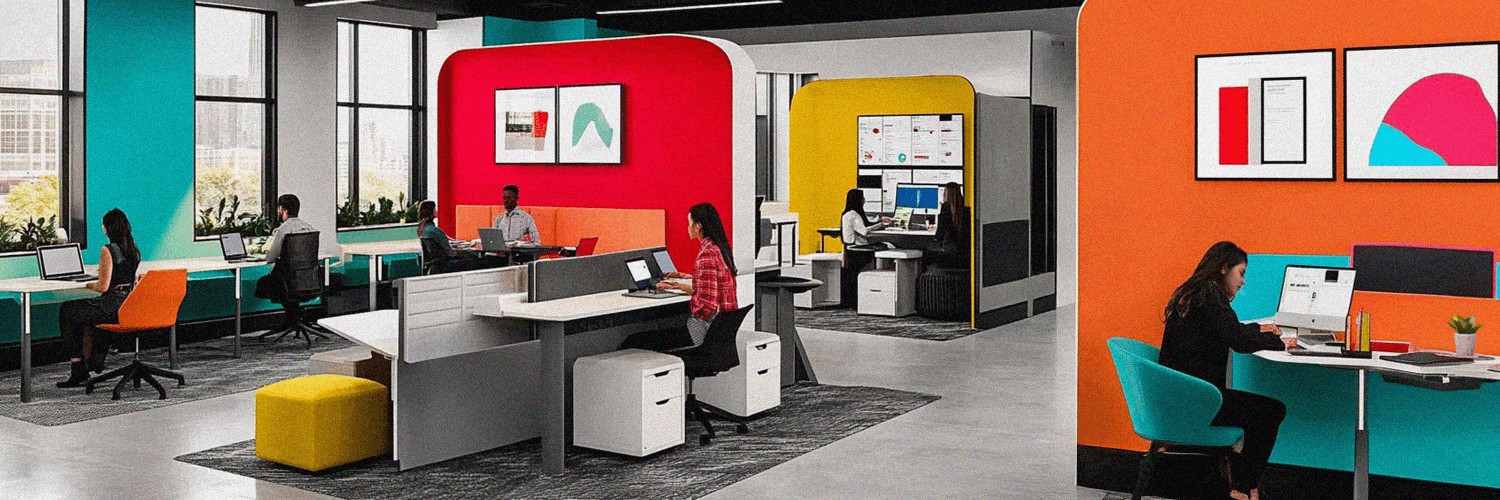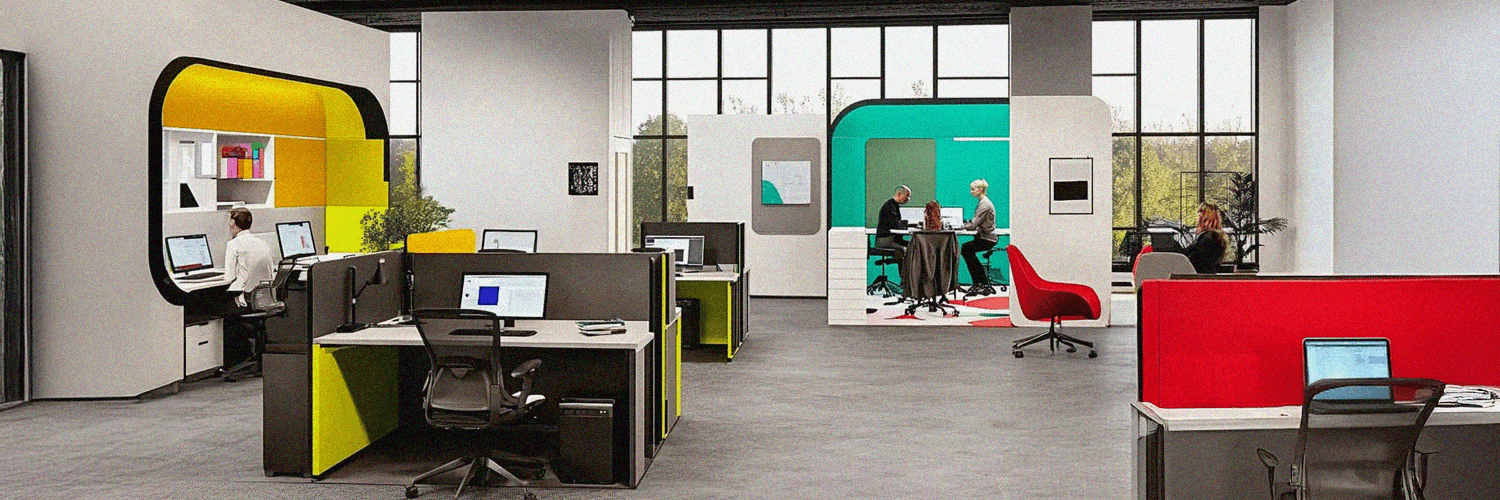As modern organizations evolve, traditional office setups no longer meet the demands of dynamic and hybrid work models. The intelligent workplace represents the next stage of workplace transformation, leveraging advanced technologies to improve efficiency, collaboration, and employee satisfaction.
But what exactly defines an intelligent workspace, and how does workplace intelligence enhance productivity?
TL;DR:
- An intelligent workplace integrates AI, automation, and IoT to enhance productivity and collaboration while supporting modern hybrid work models.
- Key benefits include improved employee engagement, optimized space utilization, enhanced security, and seamless digital collaboration.
- Challenges such as data security, integration complexity, and employee resistance can be mitigated with strategic planning, robust cybersecurity, and a culture of innovation.
Understanding the Intelligent Workspace
An intelligent workplace uses technology to create a dynamic and adaptive environment that enhances productivity, collaboration and efficiency.
While a standard digital workplace provides essential communication and collaboration tools, an intelligent workspace takes a more proactive approach. It integrates AI, automation, and real-time data analytics to anticipate needs, streamline operations, and optimize resource allocation – transforming the way employees interact with their work environment.
Defining an Intelligent Workspace
At its core, the definition of the intelligent workplace revolves around the use of real-time insights, smart devices, and AI-driven tools to promote seamless interaction between employees and their work environment.
According to an industry study, 78% of companies were planning to use more than 10 of the 15 identified technologies as anchors for the transition to hybrid work by 2025. This growing trend underlines the demand for intelligent workplace solutions that improve agility and flexibility.
Key Characteristics of Intelligent Workspaces
To fully understand the intelligent workplace meaning, it's important to recognize its key features:
- Automation and AI integration: AI-driven tools and machine learning streamline workflows and decision-making processes.
- Cloud-supported remote access: Cloud computing allows employees to securely access data and systems from anywhere, supporting hybrid work arrangements.
- Flexibility and adaptability: Intelligent workplaces support hybrid work models and ensure employees have the necessary tools to work efficiently from anywhere.
- Sustainability and wellness: Features like CO2 tracking and smart energy management contribute to environmental sustainability and employee well-being.
- Seamless connectivity: Cloud-based platforms, IoT devices, and collaboration tools create an efficient digital workspace.
- Security and access control: AI-driven security systems ensure safe and controlled access to work environments.
- Improved personalization: AI and data analytics enable customized employee experiences and workplace settings.
- Scalability and future-proofing: Intelligent workplaces grow with the business, integrating new technologies as needs evolve.
- Predictive maintenance and smart facilities: AI-driven systems anticipate maintenance needs before breakdowns occur, ensuring smooth office functionality.
How Intelligent Workspaces Differ from Digital Workplaces
Although the terms are often used interchangeably, key differences exist. A digital workplace focuses on providing tools for communication and collaboration, while an intelligent workspace actively uses data, AI, and automation to anticipate and respond to employee needs.
For example, an intelligent digital workspace could use smart sensors to analyze room occupancy and adjust lighting and temperature accordingly. This proactive approach to workspace management goes beyond basic digital collaboration tools to create a truly adaptive and intuitive environment.
Additionally, intelligent workspaces actively monitor employee productivity and engagement, providing insights that help organizations optimize employee performance and experience.
Spencer Romenco, Chief Growth Strategist at Growth Spurt, highlights the role of intuitive technology in smart workspaces: "The key to a smart workspace is intuitive assistance. Imagine a room where the lights dim automatically for a presentation or an air temperature control system when it gets too warm. It involves pre-empting needs rather than just reacting to them."
Core Technologies in Intelligent Workspaces
Artificial Intelligence and Machine Learning
AI plays a crucial role in workplace intelligence. AI-driven tools can streamline daily workflows, improve the employee experience, and provide predictive analytics to anticipate workspace needs. For example, AI can track attendance patterns and suggest optimal hybrid work schedules to ensure efficient use of space.
One example of this is Yarvis, an AI-powered workplace assistant that enhances productivity by managing schedules, optimizing meeting room availability, and streamlining hybrid work.
Automation Tools and Solutions
Automation in intelligent workplaces reduces manual effort, improving efficiency and accuracy. Automated workflows can include everything from desk booking systems to smart visitor management, ensuring smooth operations without unnecessary administrative burdens on HR.
One area where automation enhances intelligent workplace services is real-time resource allocation. Smart lighting and energy systems automatically adjust based on occupancy, contributing to sustainability efforts. Automated inventory tracking for office supplies further enhances operational efficiency.
Paul DeMott, Chief Technology Officer at Helium SEO, highlights the idea that technology should enhance the employee experience, not hinder it: "An intelligent workspace is all about creating an environment that blends technology with human behavior to make work more efficient and enjoyable. The technology available should be intuitive and accessible for everyone, regardless of their technical proficiency. It’s essential to assess the specific needs of your team and select the right tools that actually support their daily tasks.”
Workplace Management Platforms
A comprehensive workplace management platform integrates various intelligent workplace services, such as:
- Space booking: Ensuring optimal office space utilization.
- Hybrid work scheduling: Enabling employees to manage in-office and remote work efficiently.
- Visitor management: Enhancing security and streamlining check-ins.
- Digital signage: Providing real-time updates on room availability and workplace announcements.
- CO2 tracking: Monitoring air quality for a healthier work environment.
- Employee experience management: Offering feedback tools and engagement surveys.
- Smart building maintenance: AI-powered scheduling ensures proactive servicing of equipment.
Cloud Computing and Virtualized Environments
Cloud computing plays a fundamental role in intelligent workplaces by enabling remote access, data security, and collaboration. Meanwhile, virtualized environments allow employees to work from anywhere with seamless access to necessary tools and resources.
On top of that, cloud computing increases security through encrypted access controls and backup solutions that reduce the risk of data loss. Companies can scale their operations more effectively and ensure that the cloud infrastructure can adapt to business growth and the changing needs of employees.
Integration of IoT Devices and Smart Sensors
IoT devices collect real-time data on office occupancy, environmental conditions, and movement patterns. Smart sensors optimize space utilization, reduce energy waste, and improve employee comfort. IoT-powered security systems can also increase workplace safety by using biometric authentication and motion detection to control access and monitor sensitive areas.
Kaz Marzo, Operations Manager at Image Acquire, explains how AI and IoT shape these modern environments: "An intelligent workspace is more than just a tech-filled office—it’s a dynamic environment designed to enhance productivity, collaboration, and well-being. Smart workspaces integrate AI-powered tools, real-time analytics, and IoT devices to optimize efficiency while prioritizing flexibility and employee experience.”
Benefits and Impact of Intelligent Workspaces
Boosted Employee Productivity and Efficiency
Automation reduces administrative tasks, allowing employees to focus on strategic work instead of mundane tasks, eliminating workflow inefficiencies. Smart workplace systems optimize scheduling, meeting room bookings and workflow management, reducing downtime and increasing efficiency.
Enhanced Collaboration and Communication
Intelligent workspaces integrate AI-driven assistants and enhanced video conferencing tools to ensure seamless interaction between employees, whether they are working onsite or remotely. These systems promote real-time collaboration, reduce misunderstandings and increase productivity.
However, successfully implementing these technologies requires careful balance. Too many overlapping tools can lead to confusion rather than efficiency.
Marin Cristian-Ovidiu, CEO of OnlineGames.io, warns that excessive complexity can hinder adoption: "The main hurdle lies in establishing proper automation levels, because too many complexities generate employee confusion. Successful implementations require integrated functionalities between tools and comprehensive information security measures for data protection.”
Improved Space Utilization and Management
Intelligent workplace solutions ensure office space is used effectively. Smart booking systems, occupancy monitoring, and IoT-enabled sensors help companies analyze space utilization and make data-driven decisions about office layout and resource allocation, leading to savings and more efficient use of facilities.
Increased Flexibility with Hybrid Working Models
With hybrid work models becoming more and more popular, intelligent workplace solutions provide the necessary infrastructure to support the seamless transitions between remote and office work. Employees can reserve desks, schedule hybrid meetings, and access digital workspaces from anywhere, ensuring continuity and productivity regardless of location.
Effective workspaces are designed around how teams function rather than forcing rigid structures. Peter Murphy Lewis, Chief Marketing Officer at Strategic Pete, underlines this idea: "The best workspaces don't put people into static structures; they follow the way teams actually operate. That means asynchronous communication, real-time co-authoring, and systems that support rather than interfere.”
Challenges and Solutions in Implementing Intelligent Workspaces
Ensuring Data Security and Privacy
An intelligent workplace relies on interconnected systems, making it a target for cyber threats such as data breaches, phishing attacks and unauthorized access. To minimize these risks, companies can:
- Implement robust encryption: Encrypting sensitive data in the workplace ensures that it remains secure even in the event of unauthorized access.
- Adopt zero trust security models: By ensuring that only authenticated and authorized users have access to certain workplace tools and resources, security risks are reduced.
- Regular security audits and compliance checks: Conducting regular audits ensures that security measures are compliant with evolving industry standards and regulations,
- Cybersecurity training for employees: Training employees in best practices, such as recognizing phishing attempts and protecting their credentials, can reduce security vulnerabilities.
Managing Integration Complexity and Costs
Implementing intelligent workplace solutions requires careful planning and investment, but it can’t be ignored. The global smart workplace market is projected to expand at a CAGR of 14.2% between 2025 and 2032, reaching USD 133.02 billion by the end of the forecast period.
Organizations should take a phased approach and gradually introduce technologies that align with their goals. Scalable solutions that integrate with the existing systems will help manage costs and minimize disruption.
Cultivating a Culture of Innovation and Adaptability
The shift to an intelligent workplace involves changing corporate culture. Leadership should encourage employees to embrace new technologies through training and open communication, demonstrating the benefits of intelligent workplace solutions.
Addressing Employee Resistance to Change
Change often meets resistance. According to Samuel Huang, CEO of TeleAdsAgency.com, "The greatest challenge is finding the right balance between automation and usability; too many tools can actually burden employees more than simplify work.”
Demonstrating the benefits of workplace intelligence and involving employees in the transition can help ease concerns. “Best practices are centralizing communications, integrating platforms seamlessly with one another, and continually improving processes based on feedback from users,” he continues.

Best Practices for Creating and Maintaining Intelligent Workspaces
Developing a Strategic Implementation Plan
Good news: 85% of organizations recognize the accelerated adoption of new technologies as a primary catalyst for organizational transformation!
Still, before implementing intelligent workplace solutions, companies should develop a clear strategy that outlines goals, key technologies and integration processes. This roadmap will help align technology investments with business goals and ensure a smooth transition.
Designing Ergonomic and Flexible Work Environments
Workplace design plays a big role in the well-being and productivity of employees. Companies should focus on ergonomic furniture, adaptable workstations and hybrid office layouts to accommodate different work styles. Smart lighting and climate control further increase comfort and efficiency.
Fostering Employee Engagement and Feedback
Encouraging employees to provide feedback on workplace technologies and policies ensures that the solutions actually meet their needs. Regular surveys, AI-driven sentiment analysis and open discussions create a collaborative approach to continuous improvement.
Leveraging Analytics for Continuous Improvement
Data analytics help maintain an intelligent workplace. By continuously monitoring space utilization, employee engagement and system performance, organizations can make informed decisions that increase long-term efficiency. AI-driven insights help refine workplace strategies and optimize resource allocation.
As Alex Ugarte, Operations Manager, LondonOfficeSpace.com, highlights how smart solutions are reshaping office environments: “The intelligent workspaces of today are all about adaptability, automation, frictionless collaboration, and the well-being of occupants. Smart scheduling, desk booking, and occupancy tracking now allow offices to function efficiently without as much wasted space.
Many of these solutions arose from increasing remote and hybrid work patterns, with static seating and traditional layouts no longer making as much sense.”
Wrapping Up
As businesses increasingly adopt intelligent digital solutions, intelligent workplace services are becoming a critical component of the modern work environment.
Organizations that embrace workplace intelligence and prioritize a seamless, technology-driven employee experience will be best positioned for long-term success.










